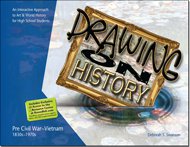Drawing on History: Pre Civil War – Vietnam (1830s – 1970s) was written for use with Beautiful Feet Book's Modern U.S. and World History course. A visual timeline at the beginning of the book shows the alignment of the books used within the Beautiful Feet Book's course and Drawing on History. However, it can easily be used alongside another resource you are using to study the modern history of the U.S. and the world to high school students to enhance your history studies with art history, art appreciation, and art projects. The book is available in print or as a PDF.
The course is clearly and simply laid out without being overwhelming. Sixteen lessons each teach a particular type of art (i.e., Romanticism, Impressionism, etc.), explaining the historical setting from which each one sprung. Often, a particular artist is highlighted as an exemplar. For example, J.M.W. Turner is the artist selected to help us learn about Romanticism. Samples of his work are shown then students try to recreate one of his paintings. In the sidebars for each lesson are the objectives; a list of art materials required; recommendations of books, weblinks, and DVDs; and a list of “Guiding Research Questions.” Lessons tend to follow the same general format: some historical background and a description of the featured art style, mentions of artists and their works from the period, a narrower focus on the highlighted artist and one or more of his or her works, and one or two art project assignments.
The Guiding Research Questions make the connections between art and history more significant, raising issues appropriate for high school students to consider. Students will need to complete research in other sources to find answers to some of the questions. For example, a question in the chapter on neo- and post-impressionism asks, “How did science affect these new artists?” Occasionally, questions require only some reflection and personal opinion. It seems to me that the questions are best used for discussion rather than written assignments, although you could use them either way. There is no answer key since most questions are rather open-ended. Author Deborah Swanson encourages parents and teachers to immerse themselves in some further reading and study of each period, and this seems essential for parents to be able to evaluate student responses to these questions. The weblinks are especially helpful for expanding upon the information in the book, but you might need to do further research or reading. Lest you feel overwhelmed, you need to know that you may use only what’s in the 64-page book—maybe even skipping the questions—for a simpler approach. Of course, you can also choose how far beyond the book you might want to go.
The weblinks in the side margins of the book are also available for easier use on the publisher’s password-protected webpage. (Your user name and password for that site are in this book.) Weblinks enhance the lessons with biographies (video and print), artworks to be viewed, instructions or techniques for projects, and patterns that might be used. Parents should probably preview the weblinks for suitability. For example, while there is no nudity in Drawing on History, there might be some on weblinks. Also, video or print material might contain more information than you want your teen to be exposed to.
For the art projects, some instructions are given in this book, and some lengthier instructions, demonstrations, or alternatives are sometimes provided through weblinks. In the text, pictures of work by other students help give a good idea of what is expected. Art projects are challenging, but many of them teach students by having them “copy the masters.” Students learn real art techniques rather than just doing arts and crafts.
A three-page lesson plan available on the password-protected webpage shows at a glance what should be done for each lesson. After the lesson plan file is a section that has a quiz and answer key for every lesson and quarterly tests with answer keys. using these is optional.
Drawing on History was written by a Christian but is not overtly religious. Questions might lead into worldview discussions but are not purposely designed to do so.










